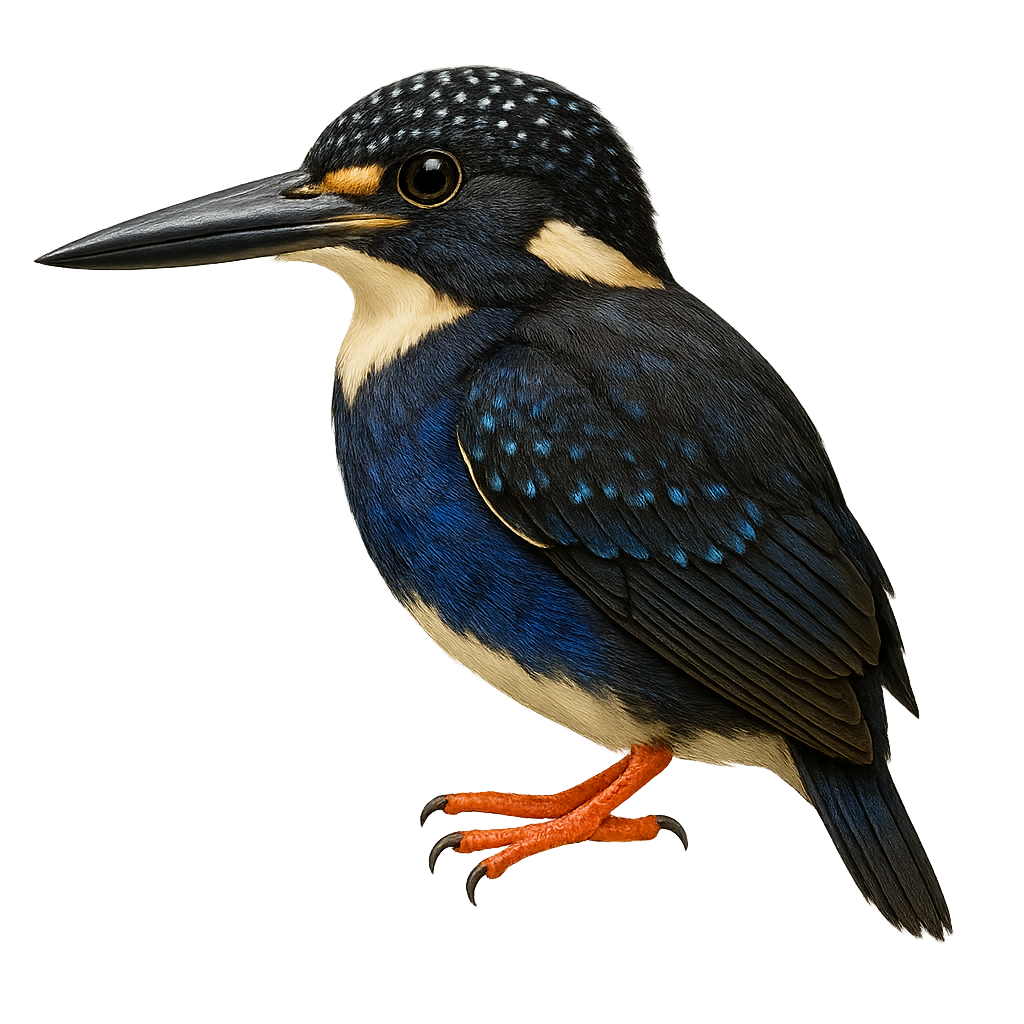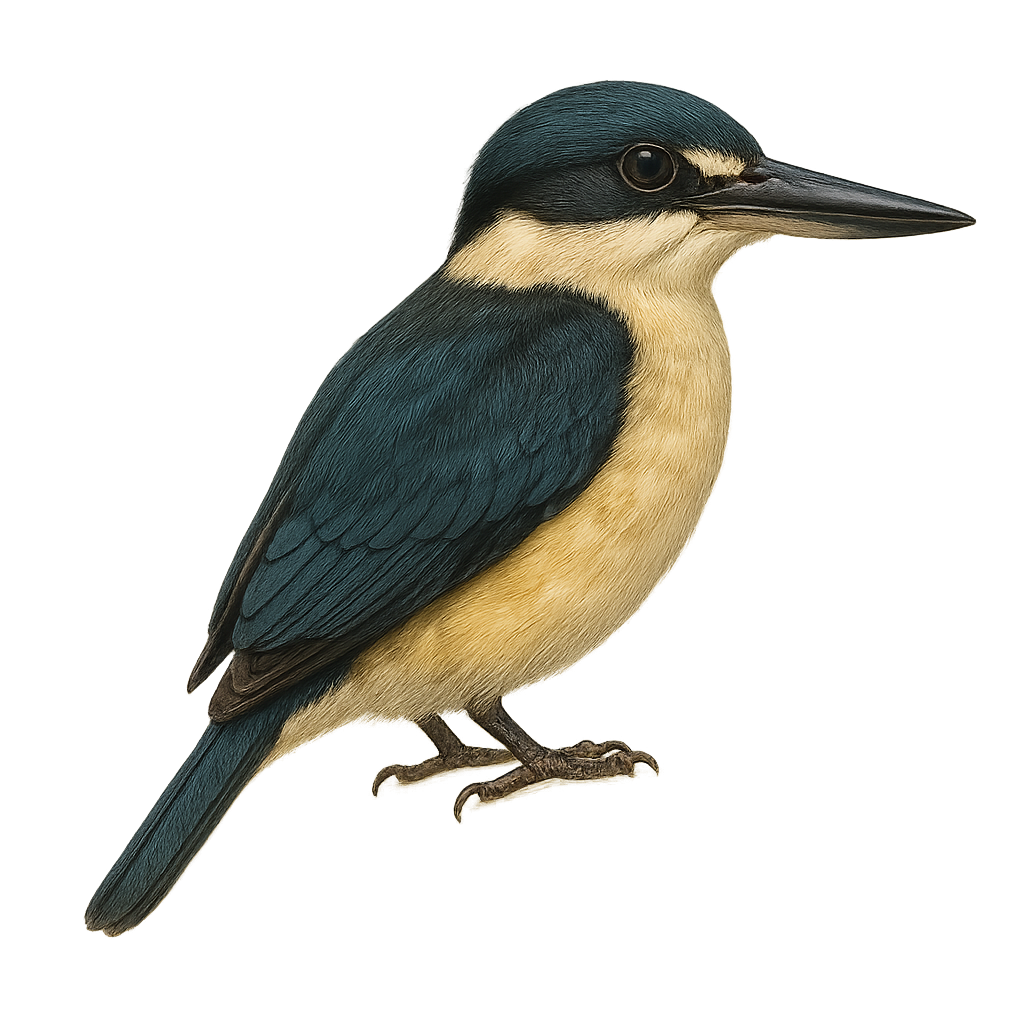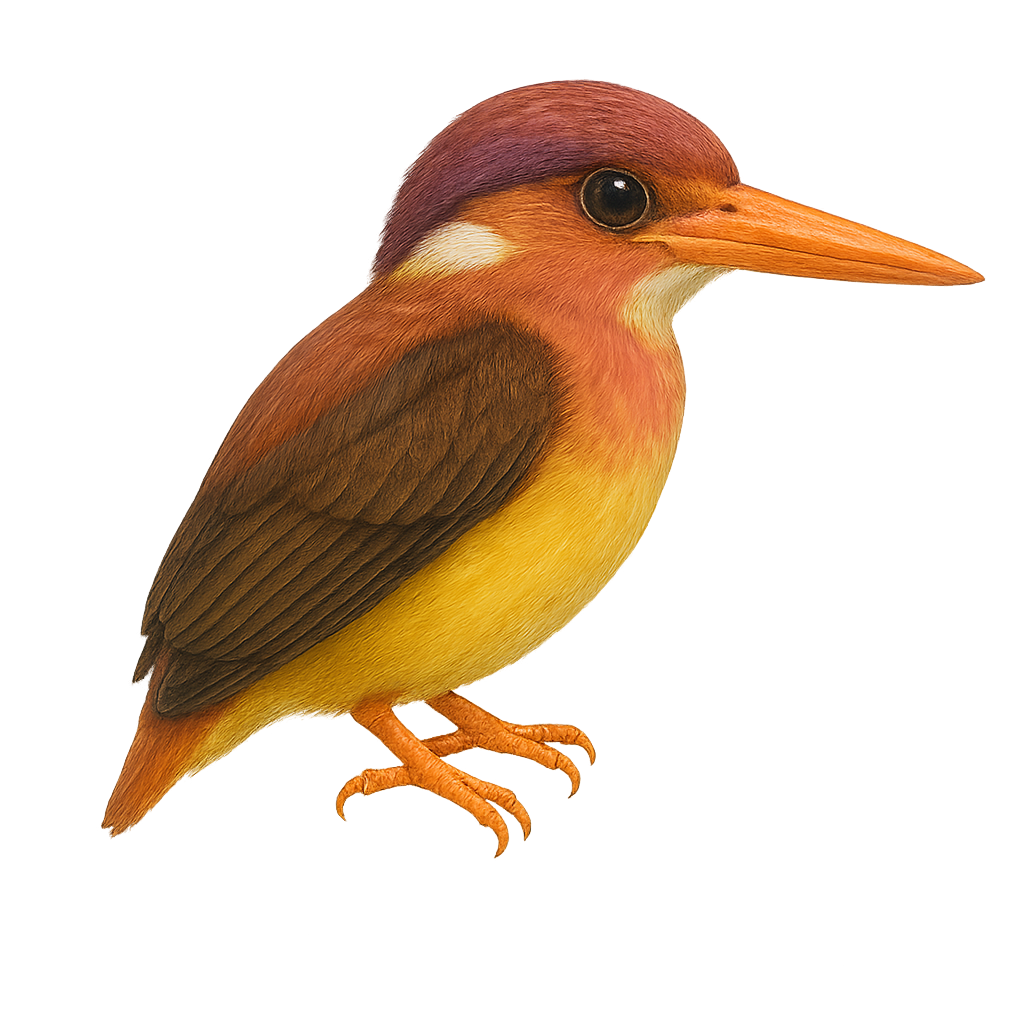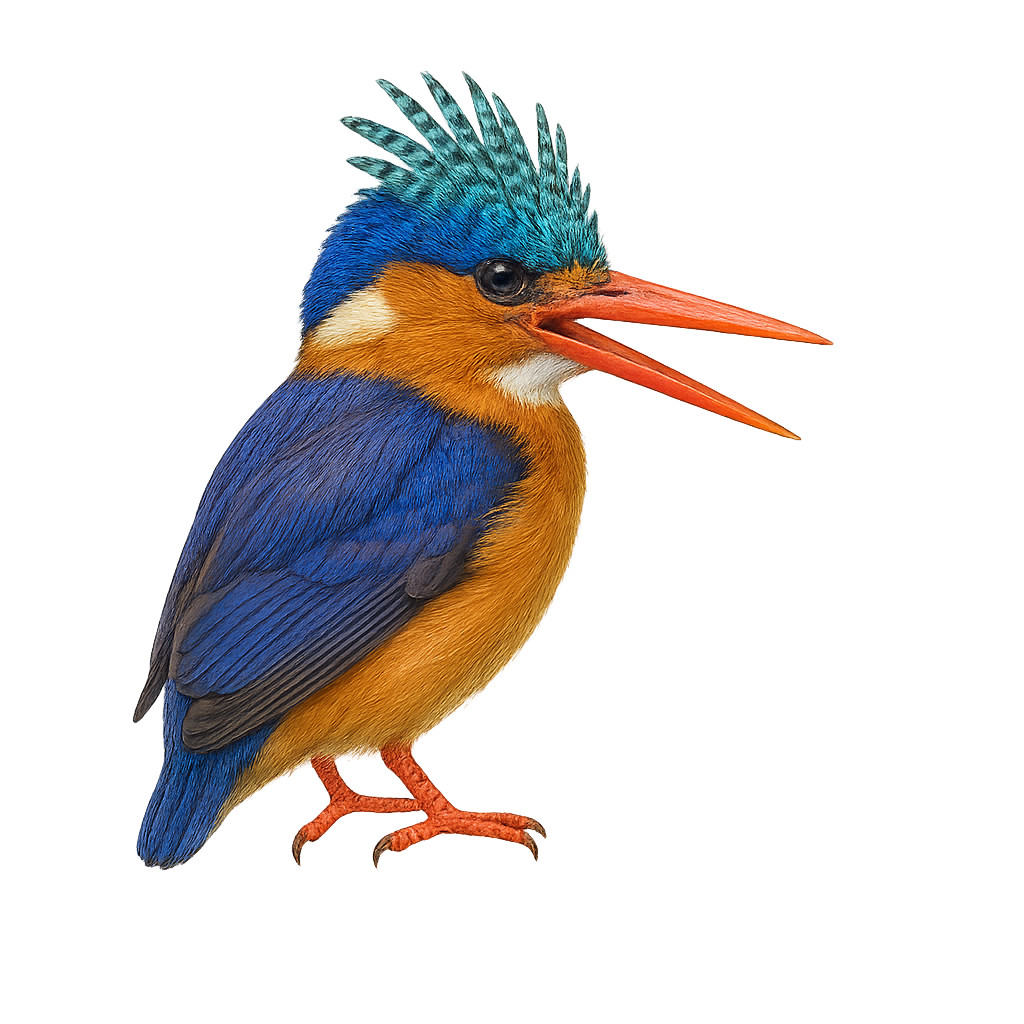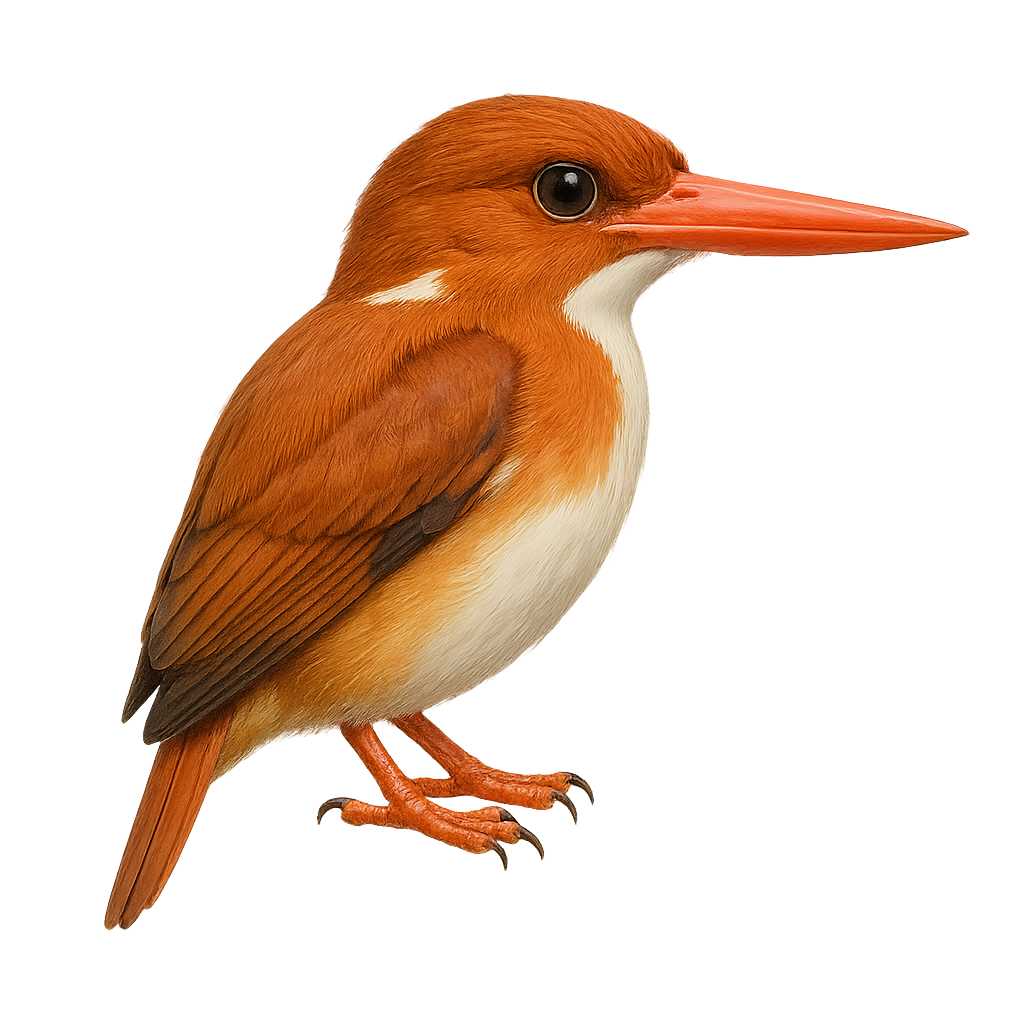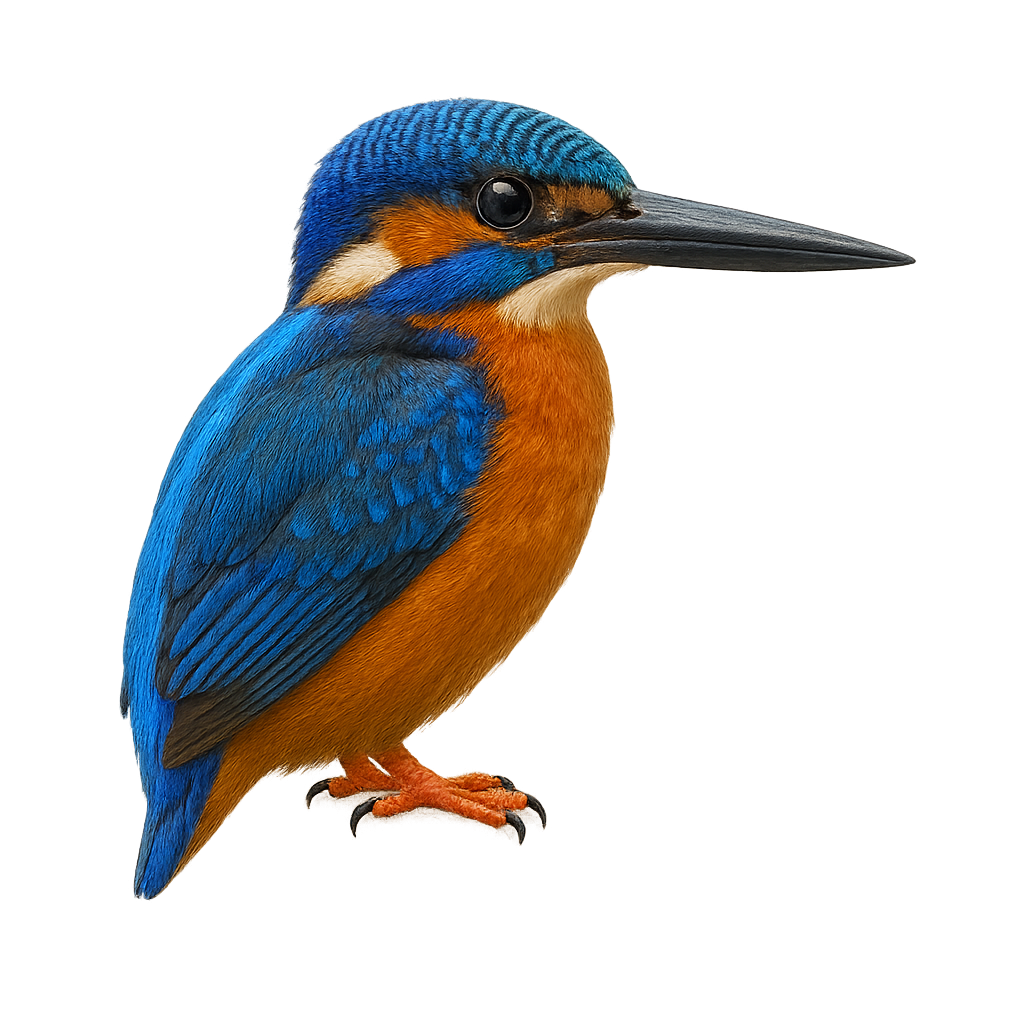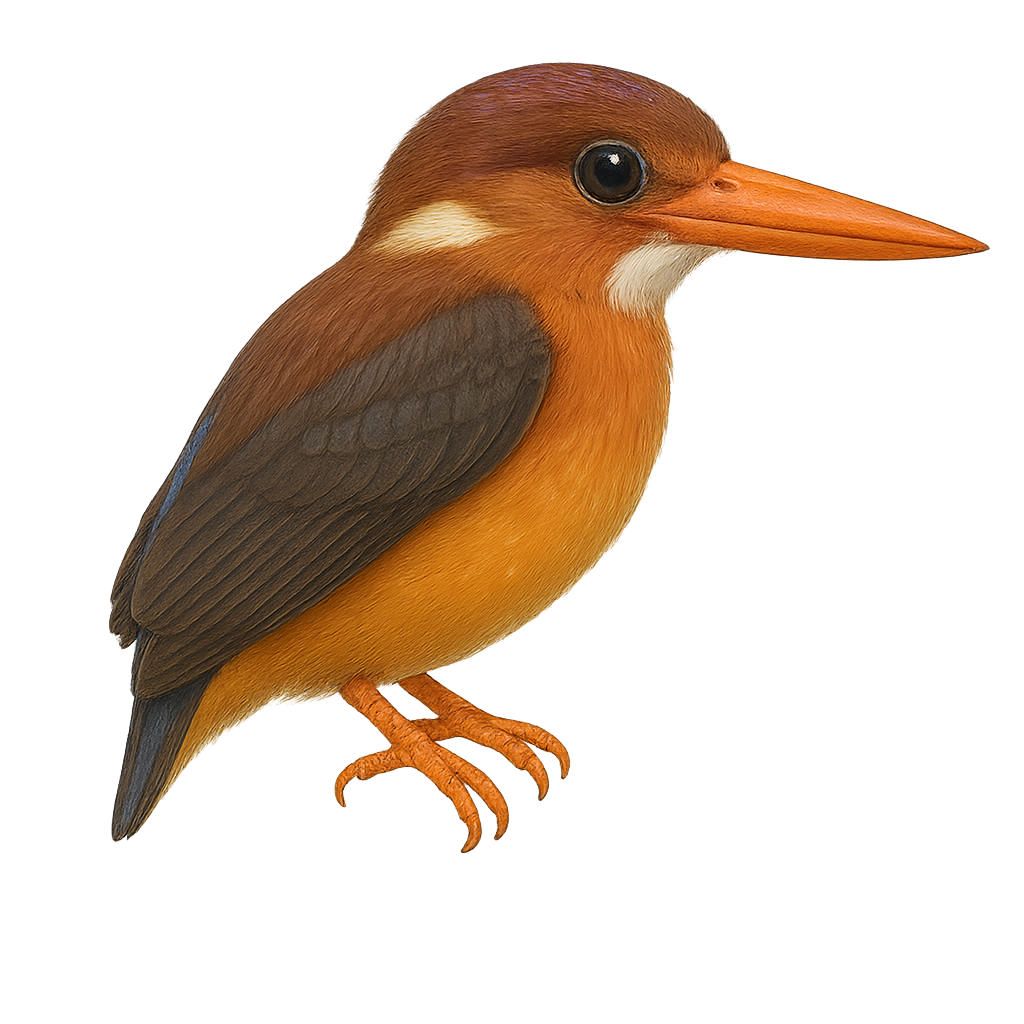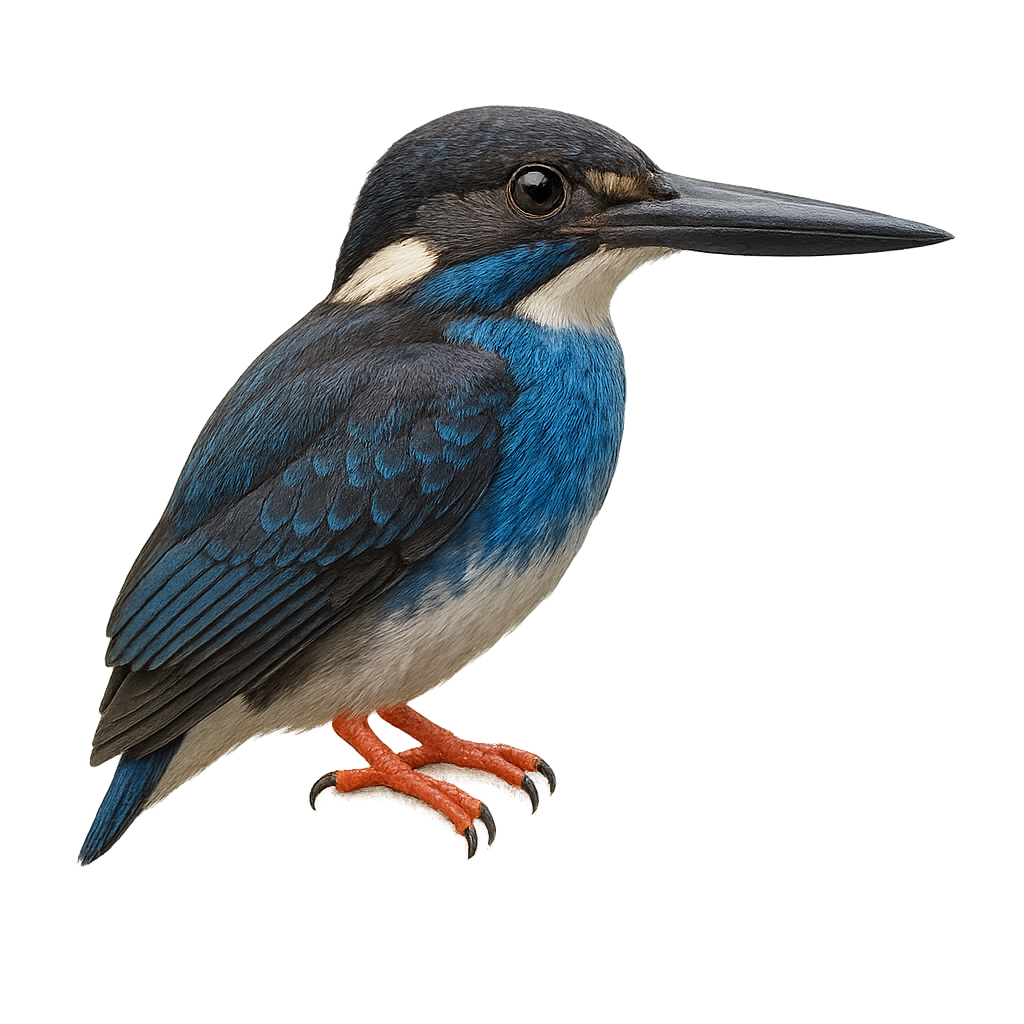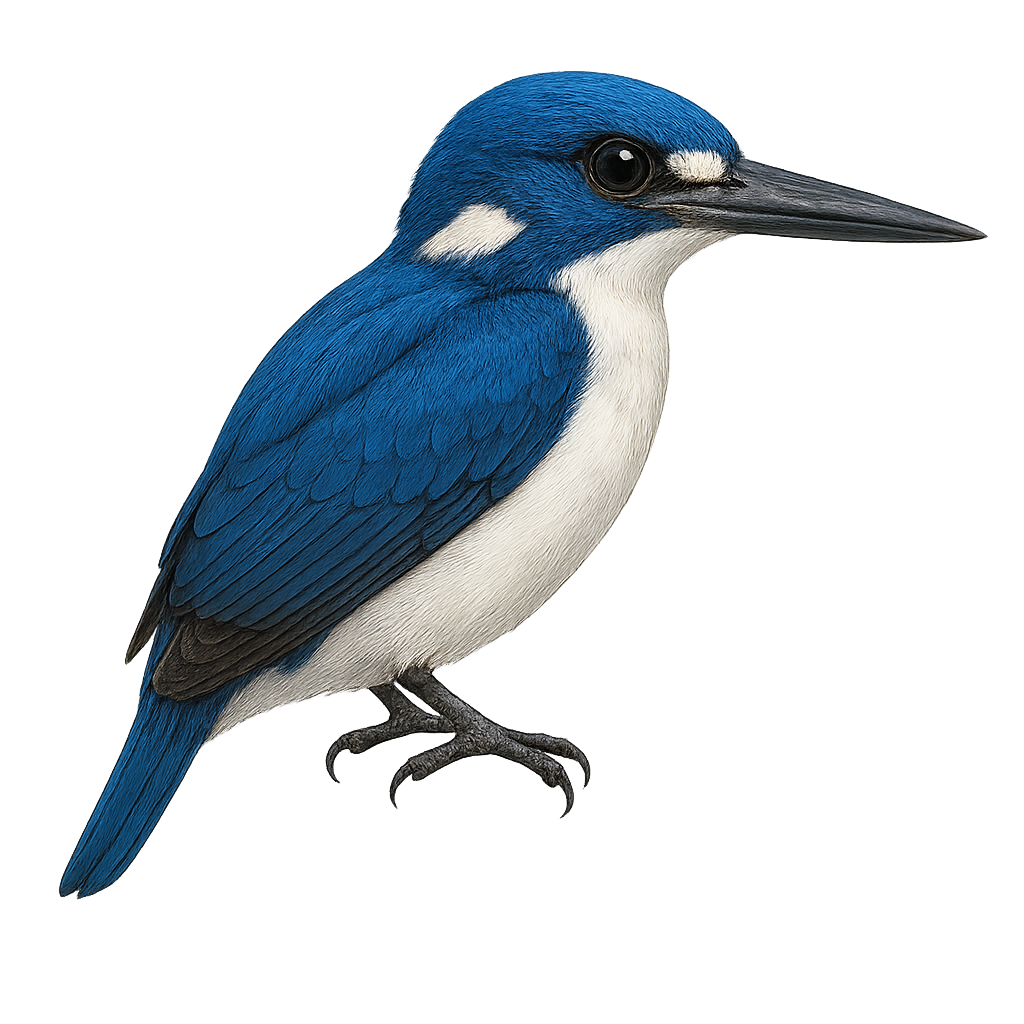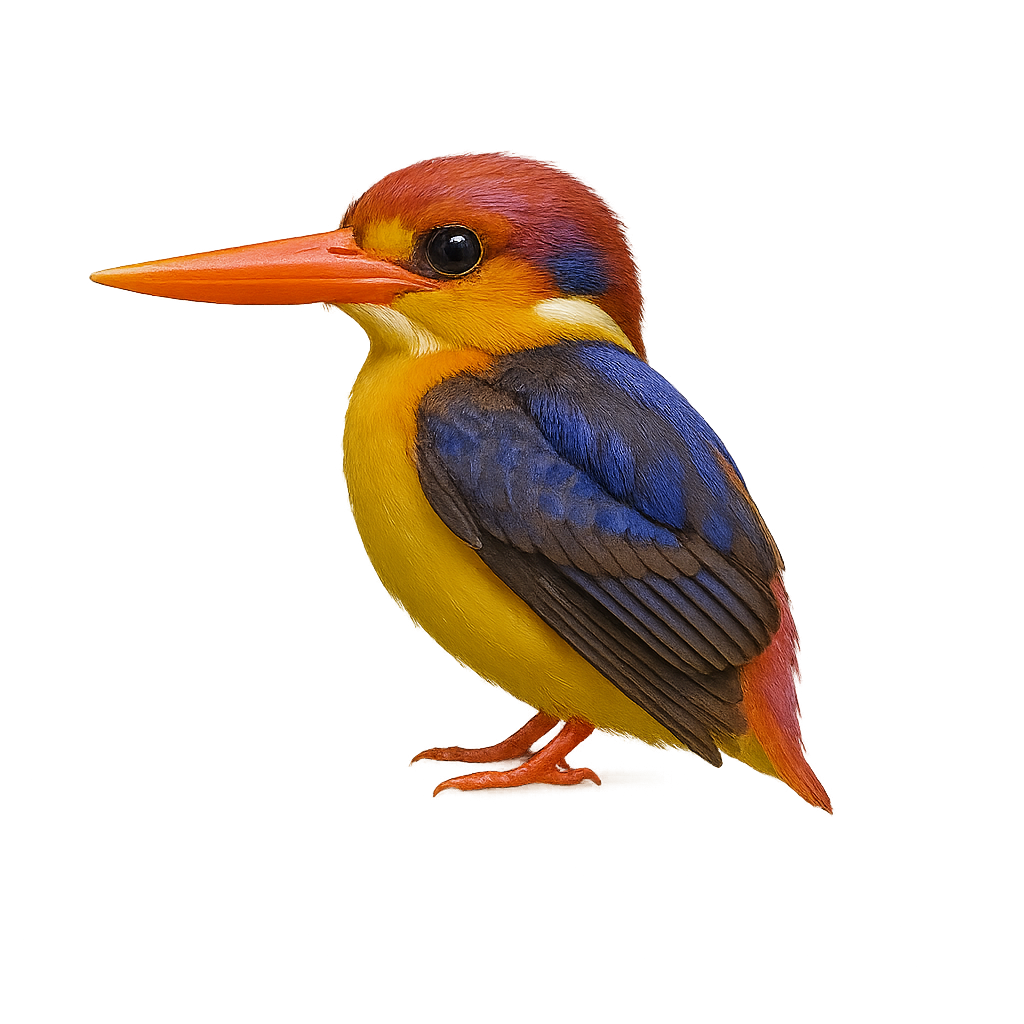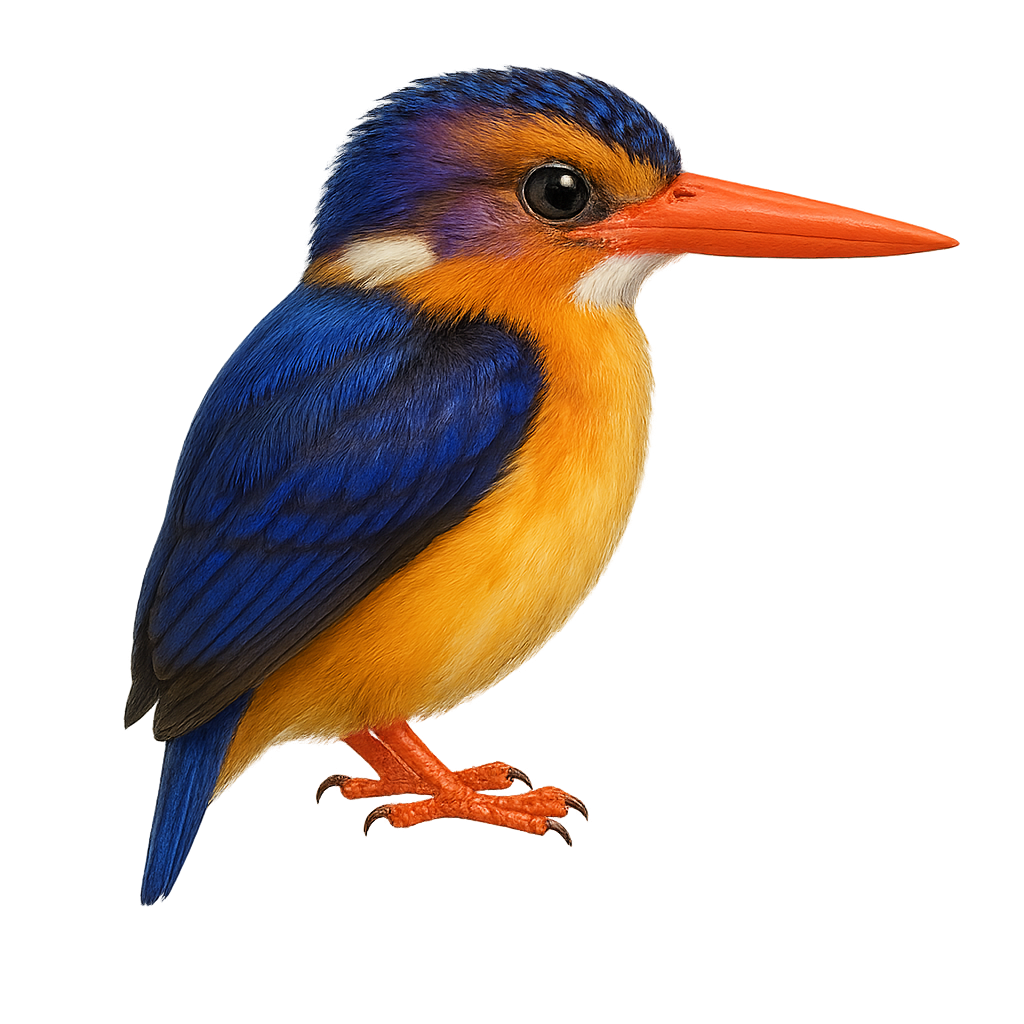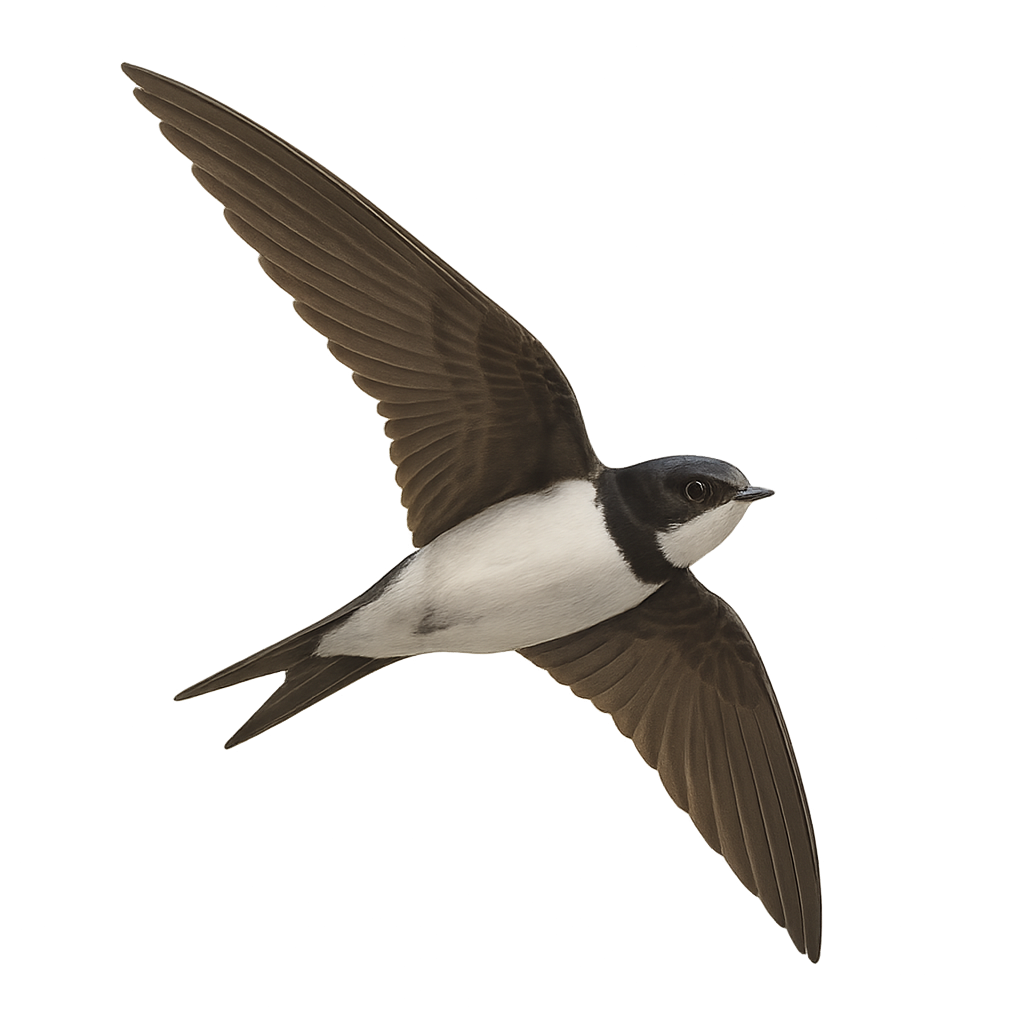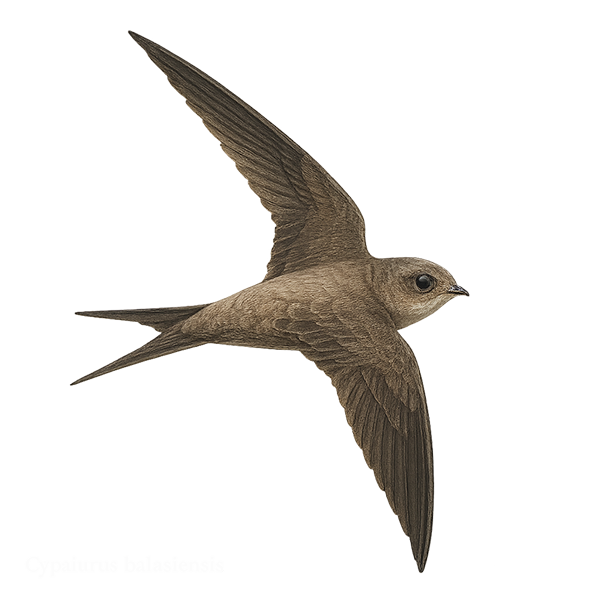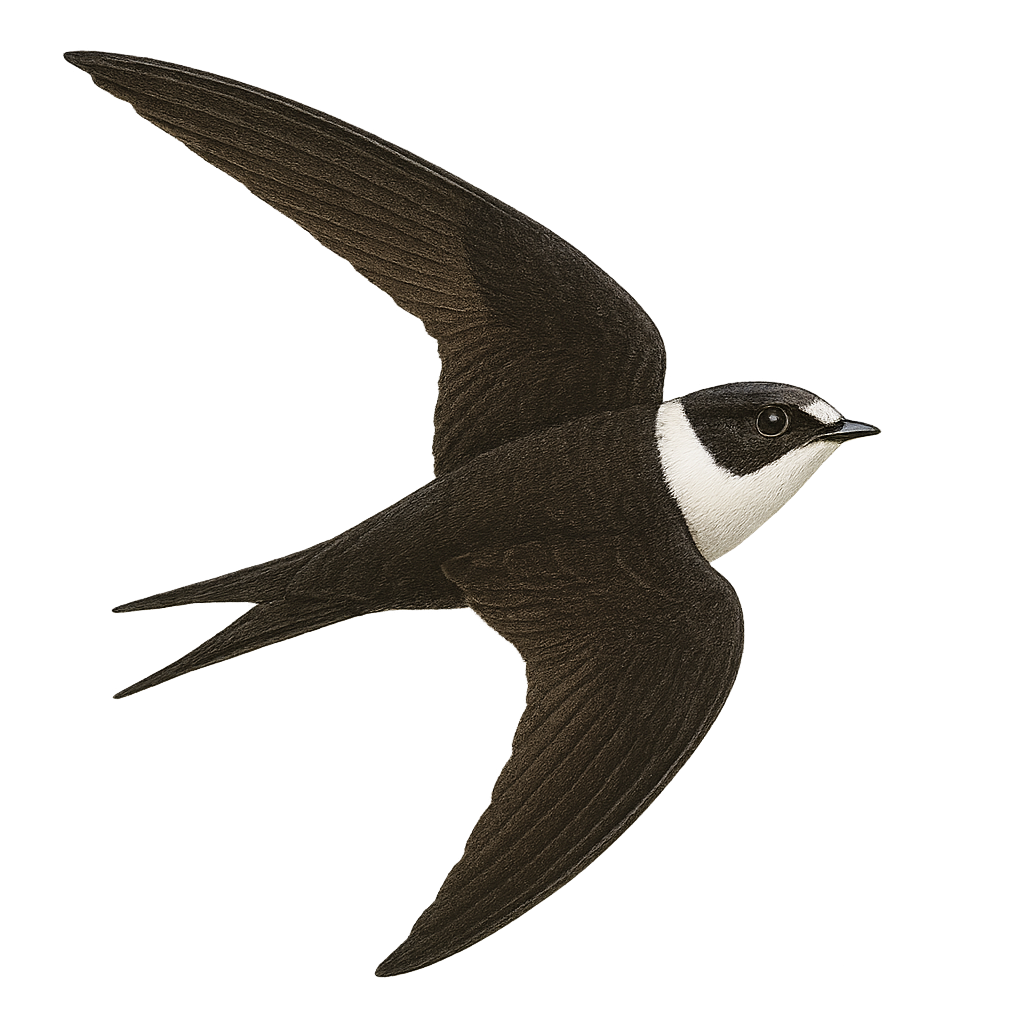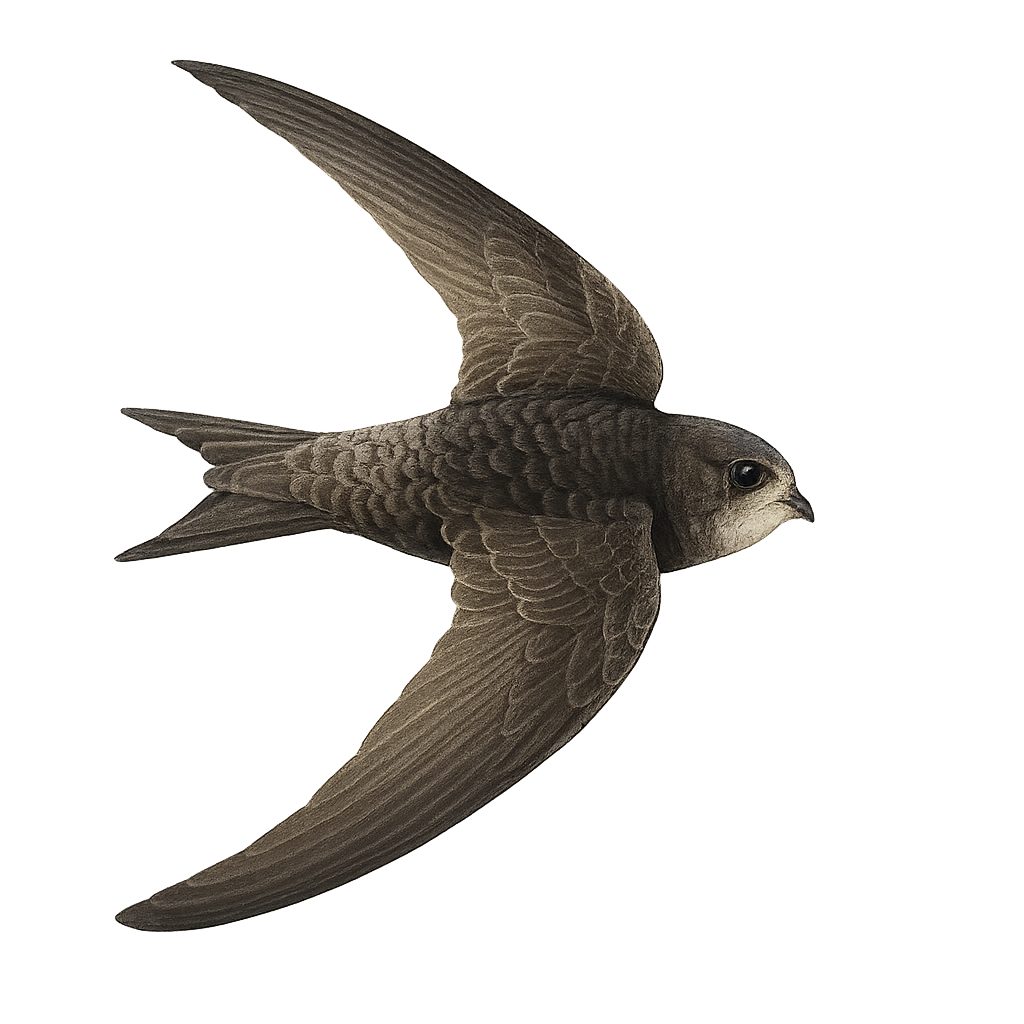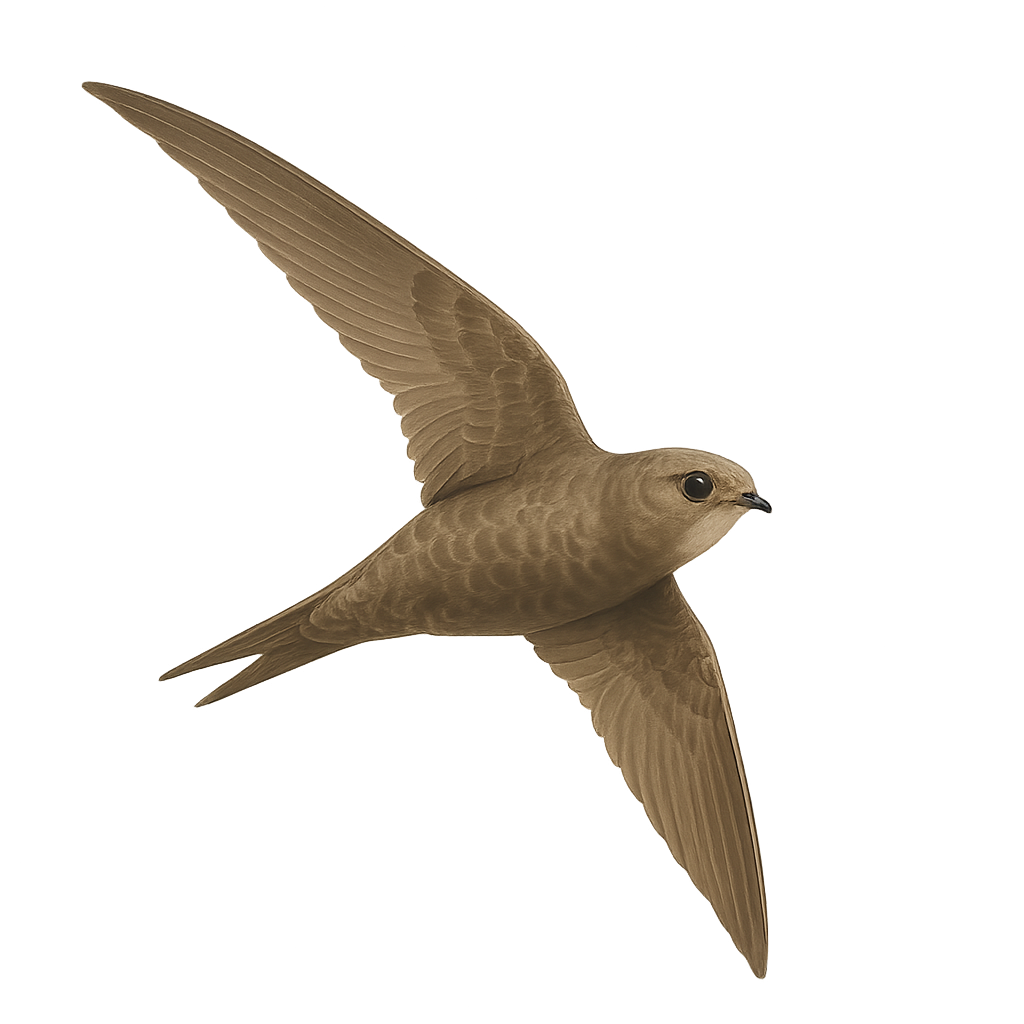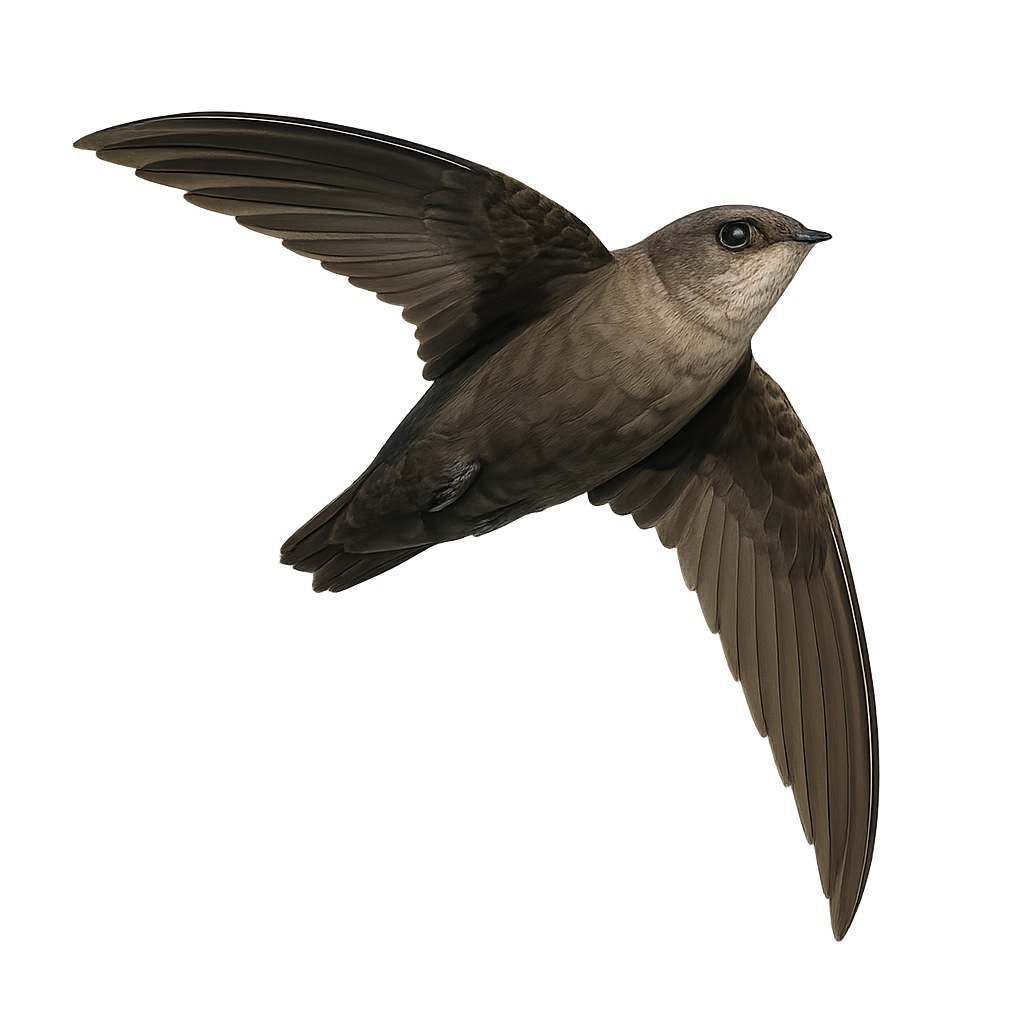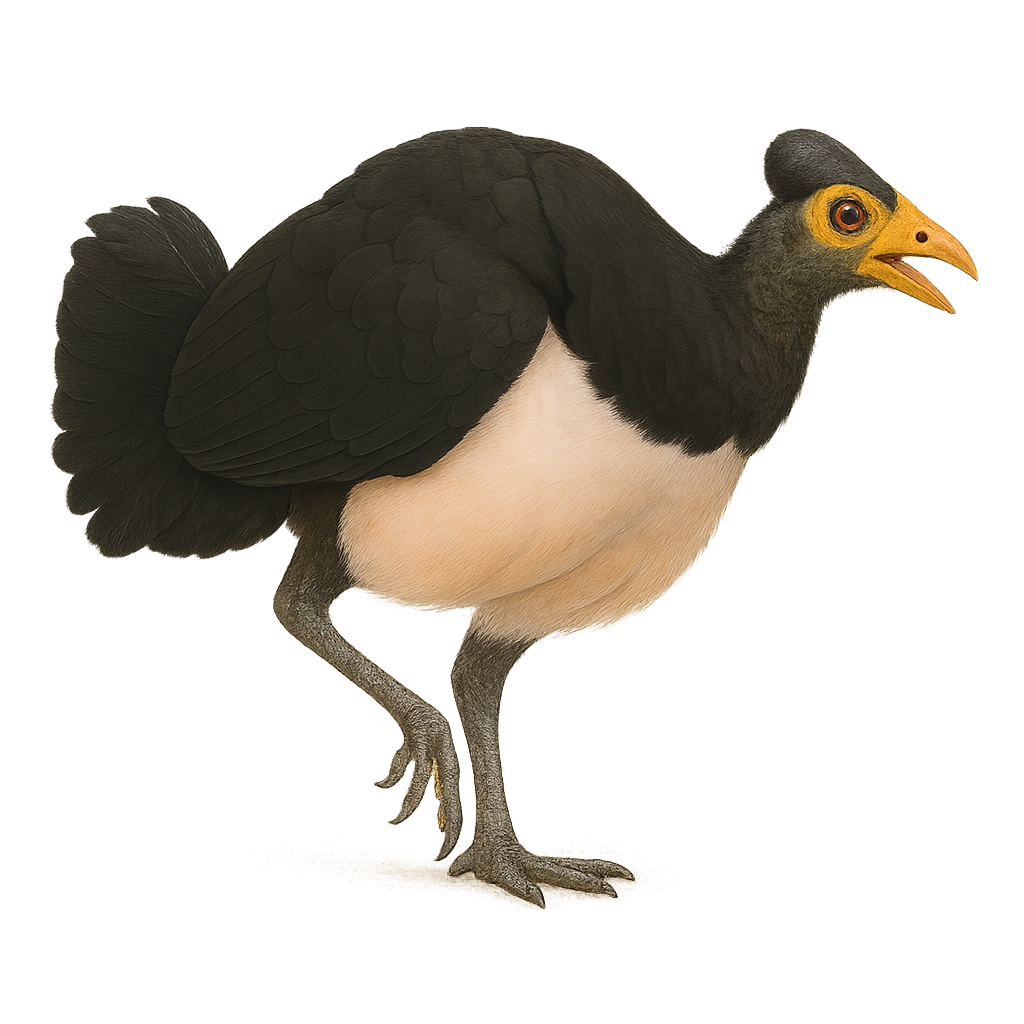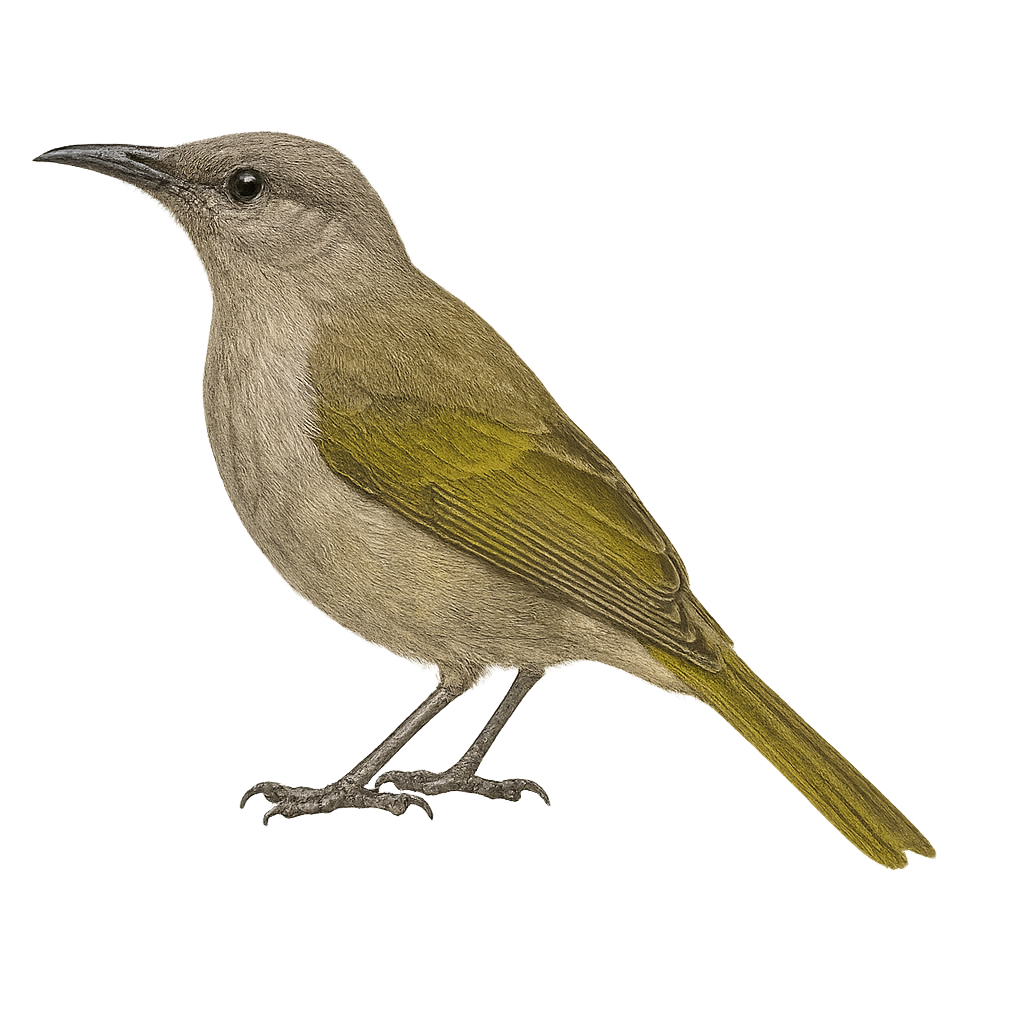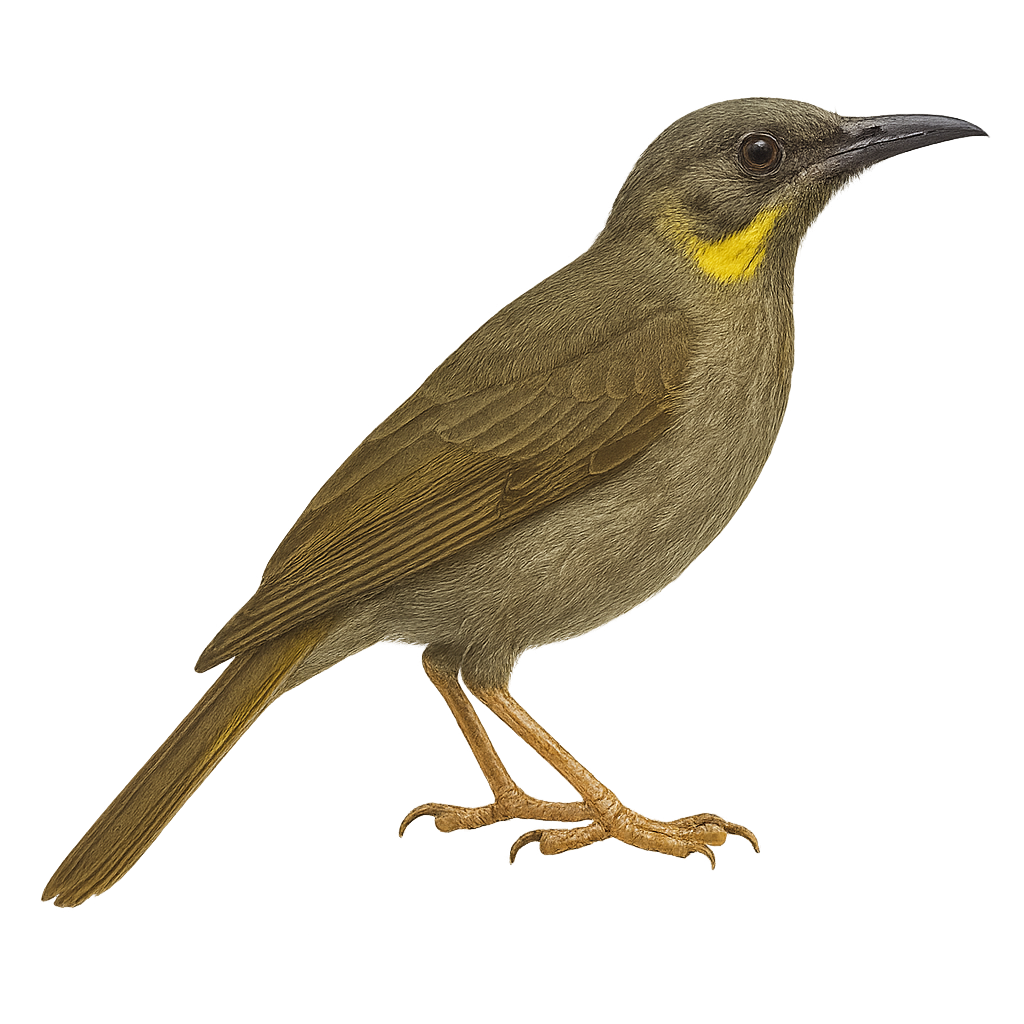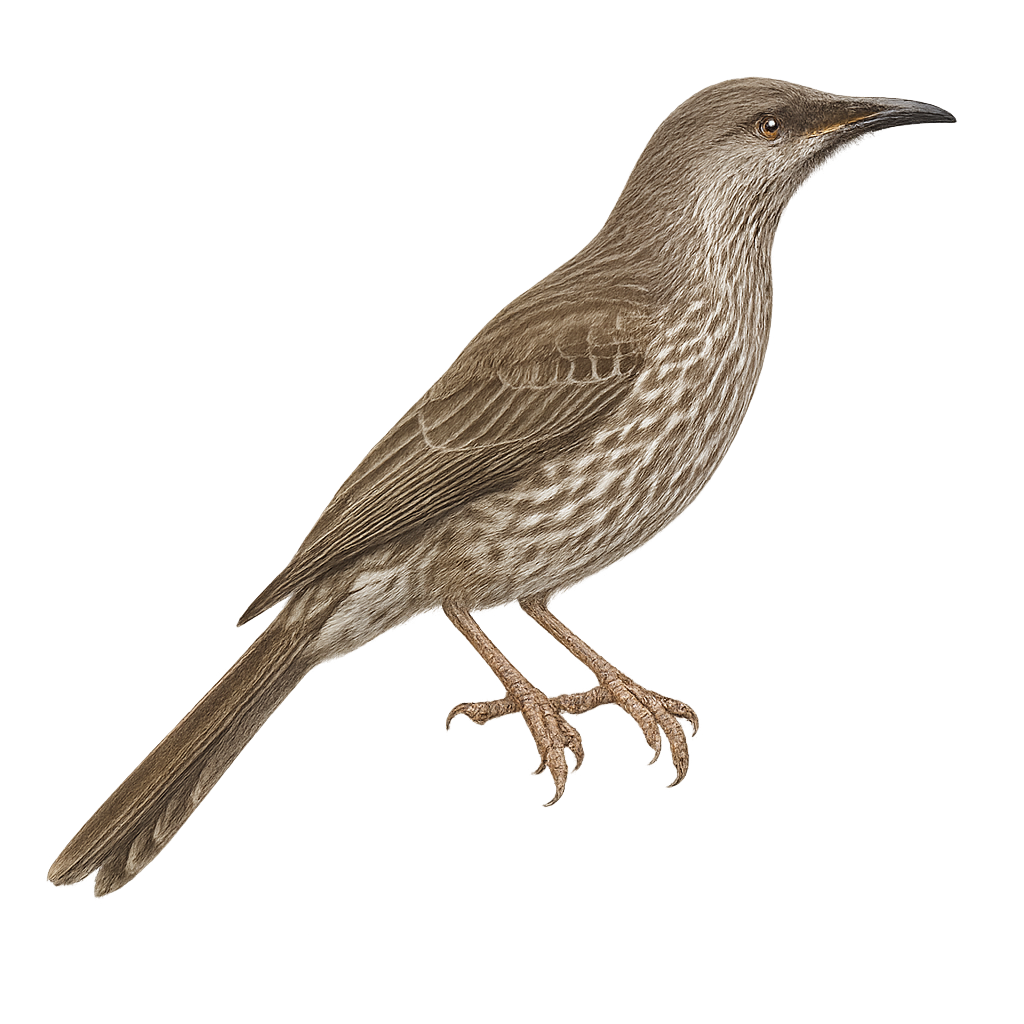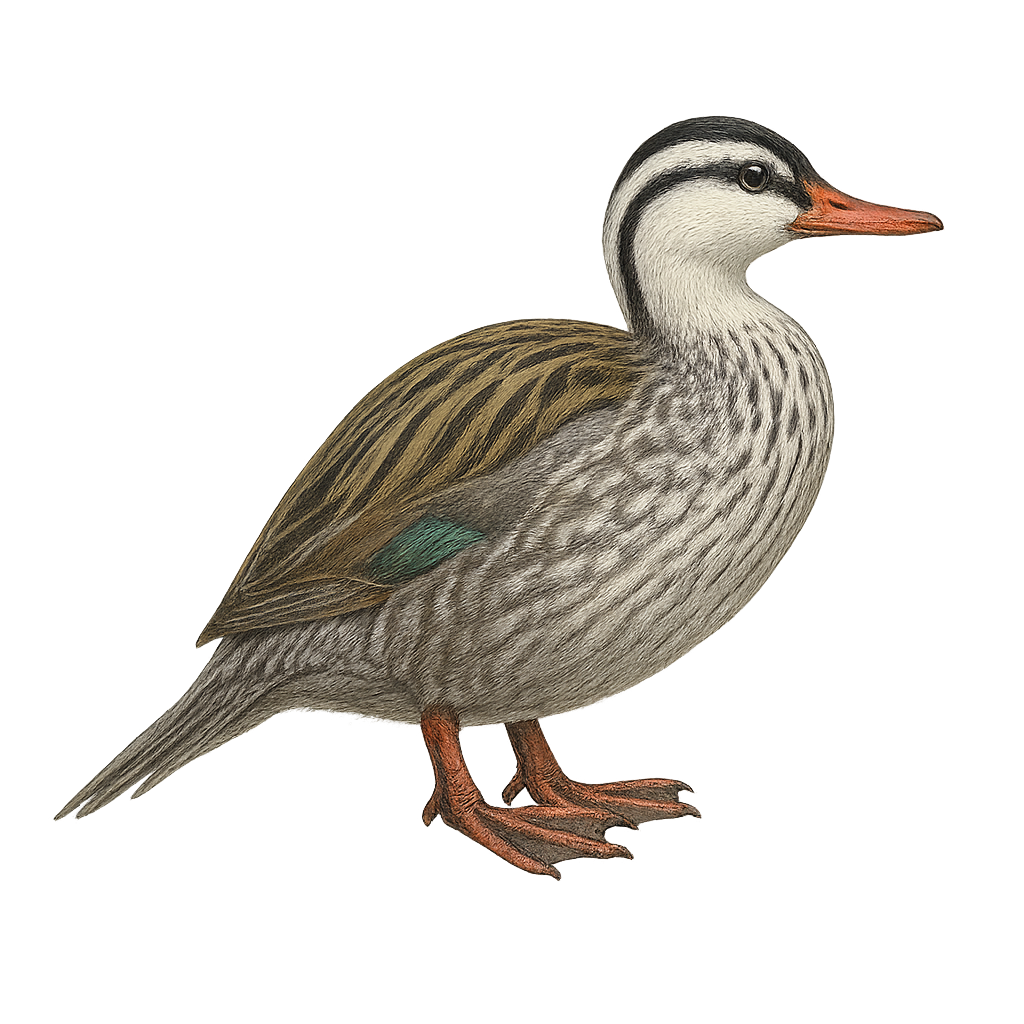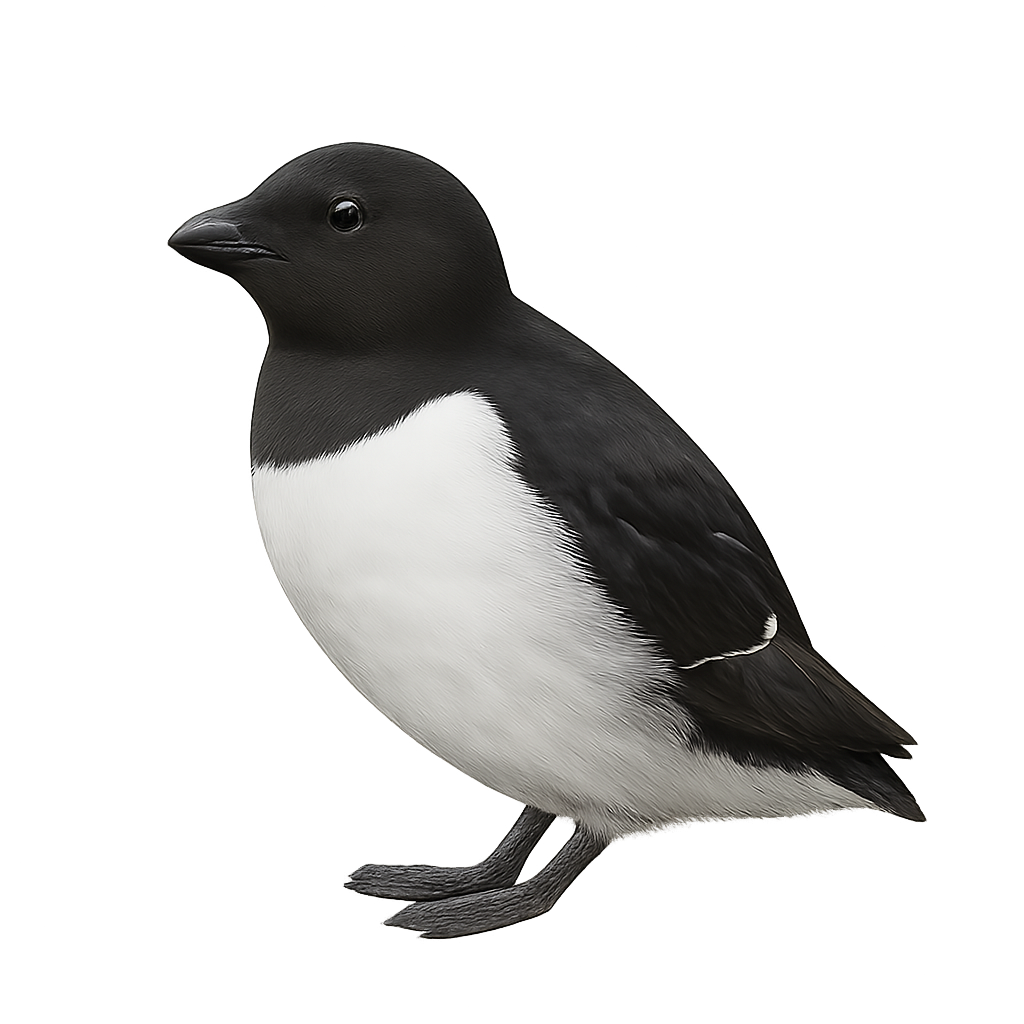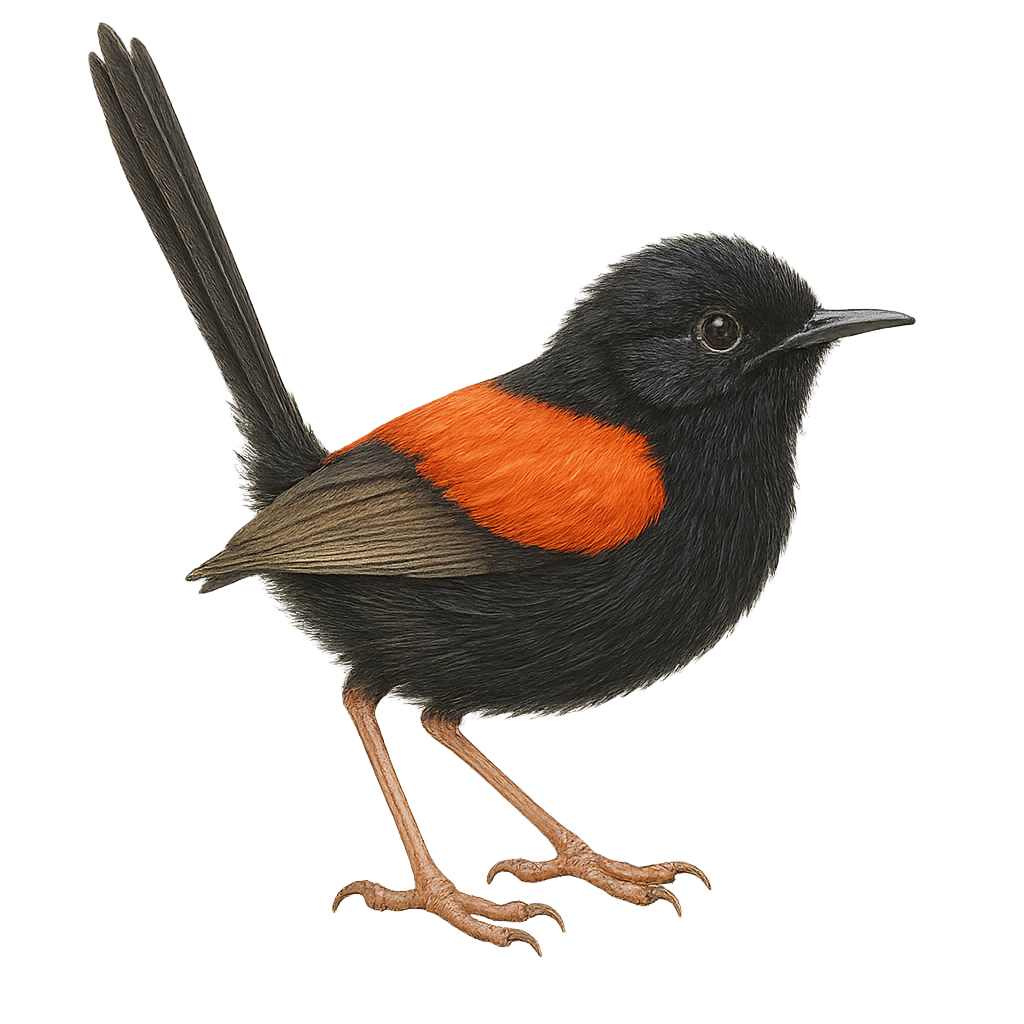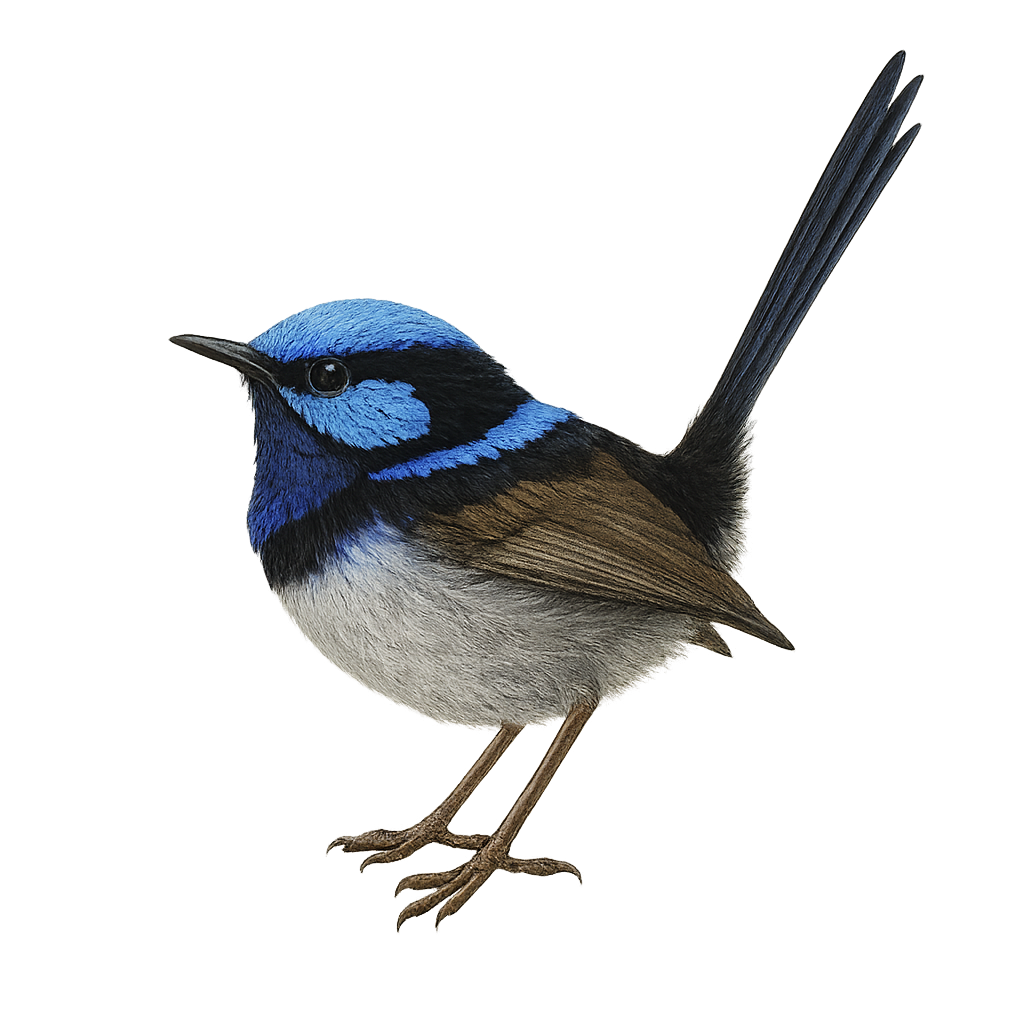The Northern Silvery Kingfisher, or Ceyx flumenicola, is a small, brightly colored bird, primarily blue and orange, found in the humid tropical forests of Southeast Asia. It is renowned for its ability to swiftly dive into water to catch fish and aquatic insects. This kingfisher prefers clear streams and slow-moving rivers, where it can easily spot its prey. Although discreet, it is often noticed due to its sharp, piercing call. Its small size and rapid flight make it difficult to observe, but its beauty makes it a favorite subject for birdwatchers and photographers.
The Bismarck Kingfisher, or Ceyx websteri, is a rare and fascinating bird endemic to the humid tropical forests of the Philippines. This small bird, measuring about 12 cm in length, is distinguished by its bright plumage with vivid blue and orange hues. It primarily inhabits wooded areas near water bodies, where it feeds on small fish and aquatic insects. Its discreet presence and shy behavior make it difficult to observe in its natural habitat. The Bismarck Kingfisher is currently classified as a vulnerable species due to deforestation and loss of its natural habitat. Conservation of this bird is crucial to maintaining the biodiversity of the Philippine forest ecosystems.
The Philippine Dwarf Kingfisher, or Ceyx melanurus, is a small bird, measuring about 13 cm in length. It is primarily found in the humid tropical forests of the Philippines. Its vivid coloration, with a black back contrasting with bright blue wings and an orange belly, makes it a striking sight. This kingfisher feeds mainly on small fish and insects, which it captures by quickly diving from a low branch. It is often seen near rivers and streams, where it builds its nest in tunnels dug into the banks. Although its population is stable, deforestation poses a potential threat to its natural habitat.
The Giant Kingfisher is the largest of the kingfisher species, measuring between 40 and 45 cm in length and weighing between 200 and 300 g. It has a distinctive plumage, with a metallic blue back, a gray head, and a white belly. Its bill is particularly long and powerful, suited for capturing large aquatic prey, such as fish, reptiles, and even crustaceans. This kingfisher primarily inhabits the banks of rivers and lakes in sub-Saharan Africa, India, Sri Lanka, and southern China, where it often hunts from branches or rocks above the water. Although it is primarily solitary in its hunting activities, it can sometimes be seen in pairs or families during the breeding season. The Giant Kingfisher is an excellent diver but is also known for its ability to catch prey while flying over the water and striking with its bill at great speed. While the species is widely distributed, it faces threats related to habitat loss and water pollution.
The Collared Kingfisher is a small colorful bird, measuring about 15 to 18 cm in length, and weighing between 20 and 30 g. It is distinguished by its head adorned with a characteristic crest made of bright blue feathers, and its brilliant plumage which combines shades of metallic blue and bright orange. Its back is cobalt blue and its belly is orange, with a striking contrast between the two. This kingfisher primarily inhabits wetlands in sub-Saharan Africa, often near rivers, marshes, and lakes, where it primarily hunts fish and aquatic insects. It is often seen diving from a perch to catch its prey, using its pointed and powerful bill to grab it with great precision. While it is generally a solitary bird, it can sometimes be seen in pairs during the breeding season. Although the population of the Collared Kingfisher is relatively stable, it faces threats such as habitat loss and water pollution.
The Malachite Kingfisher, Corythornis cristatus, is a small, vibrantly colored bird found primarily in sub-Saharan Africa. It is easily recognized by its distinctive crest and bright plumage, which features shades of blue, orange, and white. This kingfisher frequents the banks of rivers, lakes, and marshes, where it primarily hunts fish and aquatic insects. It is often seen perched on a branch or reed, patiently watching for prey before diving with precision to catch it. Despite its small size, it is an efficient and agile predator. Its breeding season varies by region, but it is generally monogamous and territorial during this time.
The Madagascar Pygmy Kingfisher, or Corythornis madagascariensis, is an endemic bird of Madagascar, known for its striking plumage. It features a bright blue head and back, contrasting with a white chest and belly. This small bird, measuring about 13 to 15 cm, is often seen near water bodies, where it primarily hunts small fish and insects. Its long, pointed beak is perfectly adapted for catching aquatic prey. Though discreet, its melodious song often echoes in the island's humid forests and mangroves. It symbolizes Madagascar's unique biodiversity, but its population is threatened by deforestation and habitat degradation.
The Blue-eared Kingfisher is a medium-sized bird, measuring about 16 to 18 cm in length. It is distinguished by its striking plumage, with bright blue shades on its back and wings, and an orange belly. Its long, pointed beak is perfect for catching fish, its main food source. It is primarily found in the humid tropical forests of Southeast Asia, near rivers and streams. This bird is often solitary and highly territorial. It is known for its spectacular hunting technique, diving swiftly into the water to catch its prey. Despite its beauty, it is often difficult to spot due to its discreet behavior and dense habitat.
The Sulawesi Dwarf Kingfisher, Ceyx fallax, is a bird endemic to the island of Sulawesi in Indonesia. This small bird, measuring about 14 cm, is renowned for its vibrant plumage, featuring shades of blue, orange, and white. It primarily inhabits tropical rainforests and mangroves, where it feeds on small fish and insects. Its long, pointed beak is perfectly adapted for catching aquatic prey. Though discreet, its melodious song often resonates in its natural habitat. Unfortunately, deforestation threatens its environment, leading to a decline in its population.
The Malaysian Blue-banded Kingfisher, Alcedo peninsulae, is a fascinating bird primarily inhabiting the tropical rainforests and mangroves of the Indo-Malayan region. This small bird, measuring about 16 cm in length, is recognizable by its bright blue plumage, darker blue wings and tail, and orange chest. It primarily feeds on small fish and aquatic insects, which it captures by diving precisely into the water. Although discreet, it is often spotted thanks to its sharp, piercing call. Its presence is an indicator of the health of the aquatic ecosystems it inhabits.
The Pied Kingfisher is a medium-sized aquatic bird, measuring about 25 cm in length and weighing between 80 and 120 g. It is easily recognized by its distinctive black and white plumage, with a black head, white back, and wings that are also black and white. Its belly is generally white, and it has a long, straight, pointed bill, perfectly suited for catching fish and aquatic insects. This kingfisher primarily inhabits coastal areas, rivers, lakes, and marshes in sub-Saharan Africa, the Middle East, and southern Asia. It primarily feeds on small fish, but can also catch insects, crustaceans, and small frogs. The Pied Kingfisher is an excellent diver, often seen diving into the water at high speed from a perch to catch its prey. While often observed alone or in small groups, it can sometimes be seen in pairs during the breeding season. While it is widely distributed, it can be threatened by water pollution and habitat loss.
The Little Kingfisher, or Ceyx pusillus, is a small, colorful bird found in the tropical forests of Southeast Asia. Known for its vibrant plumage, it features shades of blue, orange, and white. Measuring about 12 cm in length, it is one of the smallest kingfishers. This tiny bird primarily feeds on insects and small fish, which it catches by swiftly diving into the water. It prefers habitats near streams, where it can easily find food. Despite its size, it is an agile and precise hunter. The Little Kingfisher is often difficult to spot due to its discreet nature and dense habitat.
The Purple Kingfisher is a small aquatic bird distinguished by its vibrant plumage and bright colors. It measures about 16 to 17 cm in length and weighs between 30 and 40 g. Its plumage is an intense blue with purple hues and bright orange tones on the belly. This kingfisher has a long, straight, pointed bill, perfectly suited for catching fish and aquatic insects. It primarily inhabits the humid regions and tropical forests of Southeast Asia, especially in areas along rivers and marshes. The Purple Kingfisher often hunts by perching on branches or rocks near the water, diving quickly to catch its prey. While generally solitary, it sometimes forms pairs during the breeding season. Although the species is relatively widespread, it faces threats such as deforestation and pollution of waterways.
The African Pygmy Kingfisher is a small bird, measuring about 12 cm in length. It is easily recognizable by its colorful plumage, with bright blue shades on its back and wings, and an orange hue on its belly and chest. Its beak is relatively long and pointed, adapted for catching small aquatic prey. This kingfisher primarily inhabits humid forests and wooded areas near water, where it feeds on small fish, insects, and crustaceans. Although often solitary, it can sometimes be seen in pairs, especially during the breeding season. Its discreet presence and rapid flight make it difficult to spot, but its high-pitched, piercing call can reveal its presence.
The Green Kingfisher is a small, vibrant aquatic bird, measuring about 25 cm in length and weighing between 50 and 100 g. It is distinguished by its bright green plumage on its back, with a white chest and belly, sometimes tinged with orange. Its bill is long, pointed, and straight, ideal for catching fish and aquatic insects. This kingfisher primarily inhabits North and Central America, especially along rivers, lakes, and marshes. It hunts by diving directly into the water from an elevated perch, such as a tree or electrical wire, to capture its prey. The Green Kingfisher is a territorial bird, often observed alone or in small groups during the breeding season. While it is widely distributed, it faces threats such as water pollution, habitat loss, and human disturbance.
The Alpine Swift is a large swift measuring between 20 and 23 cm in length, with a wingspan of 51 to 58 cm. It has a white belly and throat, separated by a brown pectoral band, and a brown-gray back. It is often confused with the Common Swift, but it is larger and more robust. A migratory species, it winters in tropical Africa and returns to Europe between March and April. It primarily nests in inaccessible rock cavities but can also occupy urban sites. It feeds exclusively on insects captured in flight, often at high altitudes. It is monogamous, and pair bonds can last over ten years. In Switzerland, it is present from late March to late October. A protected species, it is considered potentially threatened due to the loss of its natural nesting sites.
The Asian Palm Swift, Cypsiurus balasiensis, is a small, elegant bird commonly found in the tropical regions of South and Southeast Asia. It is easily recognizable by its brownish-grey plumage and forked tail. This swift is particularly adapted to life in open areas, often near palm trees, where it builds its nest using plant materials glued with its saliva. It primarily feeds on insects caught in flight, showcasing remarkable agility. Its swift and graceful flight is a fascinating sight. Although often in motion, it can be seen resting on tree branches or power lines.
The Lesser Swallow-tailed Swift, or Panyptila cayennensis, is a fascinating bird primarily inhabiting the tropical regions of Central and South America. This small bird, about 14 cm long, is easily recognizable by its forked tail and black and white plumage. It is often observed in fast and graceful flight, capturing insects in mid-air. Its natural habitat includes tropical forests, forest edges, and sometimes urban areas. Although it is often on the move, it nests in tree cavities or artificial structures. The Lesser Swallow-tailed Swift is a social bird, often seen in groups, and its ability to fly at high speeds allows it to easily escape predators.
The Common Swift, Apus apus, is a migratory bird known for spending most of its life in flight. With a wingspan of 40 to 44 cm, it is easily recognizable by its crescent-shaped silhouette and dark plumage. Common Swifts are masters of the sky, capable of traveling thousands of kilometers without landing. They feed on insects caught in flight. Their high-pitched call is often heard before they are seen. These birds nest in crevices of buildings or cliffs, and their annual return is a herald of summer.
The Pale Swift is a migratory bird species that is mainly found in southern Europe, the Middle East, and North Africa. This small bird is easily recognizable by its grayish color and sleek body, perfectly adapted for speed and maneuverability in flight. It spends most of its life in flight, only landing to breed. It feeds primarily on insects that it catches while flying, often at high speed. The Pale Swift is an open-sky bird, frequently seen at high altitudes near mountains or soaring over urban areas in search of food.
The Chimney Swift, Chaetura pelagica, is a small migratory bird known for its rapid and agile flight. It is often seen in urban areas, nesting in chimneys and similar structures. Its plumage is primarily dark brown, making it difficult to spot when flying high in the sky. These birds are insectivores, feeding mainly on small flying insects caught in mid-air. Their high-pitched call is often heard before they are seen. Chimney Swifts are social birds, frequently observed in large groups, especially during migration. They play a crucial role in controlling insect populations, thus contributing to ecological balance.
The Maleo, or Macrocephalon maleo, is an endemic bird of Sulawesi, Indonesia. Recognizable by its distinctive black crest and black-and-white plumage, this bird is famous for its unique breeding method. Unlike most birds, the maleo buries its eggs in the warm sands of volcanic or geothermal beaches, using natural heat for incubation. Once hatched, the chicks must fend for themselves, digging their way to the surface and flying immediately. The maleo is an endangered species, mainly due to habitat loss and egg collection by humans. Conservation efforts are underway to protect this fascinating bird and its natural habitat.
The Brown Honeyeater, or Lichmera indistincta, is a small bird native to Australia and New Guinea. Its plumage is generally olive-brown with lighter underparts. This bird is particularly appreciated for its melodious and varied song. It inhabits a range of environments, from tropical forests to urban areas, and primarily feeds on nectar, although it also consumes insects and fruits. Its slender, curved bill is perfectly adapted for extracting nectar from flowers. The Brown Honeyeater plays a crucial role in the pollination of native plants. It is often seen in small groups but can also be solitary.
The Wattled Honeyeater, or Foulehaio carunculatus, is a medium-sized bird belonging to the Meliphagidae family. It is primarily found in the South Pacific islands, notably in Fiji, Samoa, and Tonga. This bird is distinguished by its olive-green plumage and characteristic red wattles around its head. It mainly inhabits tropical rainforests but can also be seen in gardens and wooded areas. The Wattled Honeyeater primarily feeds on nectar but also consumes insects and fruits. Its song is a mix of whistles and chirps, often heard at dawn and dusk.
The Ornate Melidectes, or Melidectes torquatus, is a bird endemic to New Guinea. It is characterized by its olive-brown plumage with a distinctive white collar around its neck. This bird measures about 20 to 25 cm in length and has a slightly curved beak, adapted to its diet mainly consisting of nectar and insects. It primarily inhabits tropical rainforests and mountainous areas, playing a crucial role in plant pollination. Although generally suspicious, it can become accustomed to human presence in protected areas. Its population is stable, but deforestation poses a potential threat to its natural habitat.
The Western Wattlebird, or Anthochaera lunulata, is a bird endemic to Australia, primarily found in wooded regions and open forests. It is distinguished by its brown-grey plumage with white crescent-shaped markings on the chest, hence its name. This bird is known for its loud and varied song, often heard before being seen. It primarily feeds on nectar but also consumes insects and fruits. The Western Wattlebird is a sociable bird, often observed in small groups. It plays a crucial role in pollinating local plants. Although generally tolerant of humans, it can become territorial during the breeding season.
The Torrent Duck, Merganetta armata, is a unique aquatic bird primarily found along mountain rivers in South America. This duck is distinguished by its exceptional adaptation to fast currents and turbulent waters. The male features a distinctive plumage with a white head striped with black, while the female displays more subdued shades of brown and gray. Their beak is thin and pointed, ideal for catching aquatic insects and larvae, their main food source. Torrent Ducks are often seen in pairs or small family groups, skillfully navigating rapids with their powerful legs and sharp claws. Their ability to dive and swim against the current is remarkable, making them specialists in their habitat.
The Little Auk is the smallest of the Atlantic alcids, measuring about 19 to 21 cm in length with a wingspan of 34 to 38 cm. Its plumage is black on the back and head, with a white face and belly. It has a short, stout bill adapted for catching small marine prey. A gregarious species, it forms massive breeding colonies on Arctic rocky coasts, nesting in crevices or under boulders. Outside the breeding season, it lives in the open sea, often near pack ice. It feeds mainly on copepods, krill, and small fish, which it captures by diving. Although currently listed as Least Concern, climate change and ocean pollution pose potential threats to its habitats.
The Red-backed Fairywren is a small passerine bird endemic to Australia, belonging to the Maluridae family. It is easily recognizable by its distinctive plumage: the male sports a bright red back and a black head during the breeding season, while the female and juveniles have more subdued brown plumage. This small bird measures about 11 to 13 cm in length and weighs between 5 and 10 grams. It primarily inhabits savannas, grasslands, and open shrublands. The Red-backed Fairywren is a social bird, often seen in small groups. It feeds mainly on insects and small invertebrates, which it captures by nimbly hopping among grasses and bushes.
The Superb Fairywren, or Malurus cyaneus, is a small passerine bird native to Australia. It is easily recognizable by its striking plumage: males display a vibrant blue on their head and back, while females and juveniles are predominantly brown. This striking contrast is especially noticeable during the breeding season. The Superb Fairywren inhabits mainly open forests, scrublands, and urban gardens, where it feeds on insects and small invertebrates. Sociable by nature, it lives in family groups and practices cooperative breeding, with several individuals helping to raise the young. Despite its small size, this bird is very active and agile, often moving in quick, small hops.


